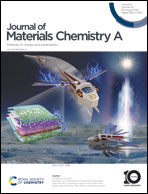Synthesis and Brønsted acid doping of solution processable poly(thienylene vinylene) for thermoelectric application†
Abstract
Doped polythiophene (PT)-based semiconductors are of significant interest in the field of organic electronics, and are designed for novel thermoelectric applications based on their remarkable electrical properties, ease of processing, and tunable molecular structures. In the present study, the effects of the vinyl linkers in the PTs are systematically investigated in order to understand the interdependence of the structural properties, thin film morphologies, and thermoelectric performance. In particular, the soluble poly(thienylene vinylene) (PTV)-based conjugated polymer, poly[3,4-bis(2-ethylhexyl)thienylene vinylene] (P3,4EHTV), is synthesized via halogen-free and transition metal-free polymerization, and compared with the often-studied poly[3-(ethylhexyl)thiophene] (P3EHT) analogue. In addition, the thermoelectric properties of these two PT films doped with tris(pentafluorophenyl)borane (B(C6F5)3, BCF) are characterized. Furthermore, the bipolaron states of the doped P3,4EHTV are retrieved via detailed ultra violet-visible-near infrared (UV-vis-NIR) and electron paramagnetic resonance (EPR) spectral analyses. Systematic microstructural characterizations reveal that the introduction of vinyl groups into the conjugated polymer backbone results in good miscibility with the BCF dopant, along with enhanced doping efficiency, thereby providing the appropriate sites for accommodating the dopant without disrupting the original chain packing and charge transport channels. The maximum power factor (PF) is measured as 1.47 μW m−1 K−2 for the BCF-doped P3,4EHTV with a molar ratio of 20%, due to the high electrical conductivity (σ) of 0.34 S cm−1, which is ten-fold higher than that of the P3EHT (0.17 μW m−1 K−2). The present study therefore provides a suitable methodology for the realization of doped polymers with good host-dopant miscibility, compatible morphologies, and undisrupted microstructural packing in order to favor an increased power factor by introducing vinylene linkers into the main chains of PTs.



 Please wait while we load your content...
Please wait while we load your content...